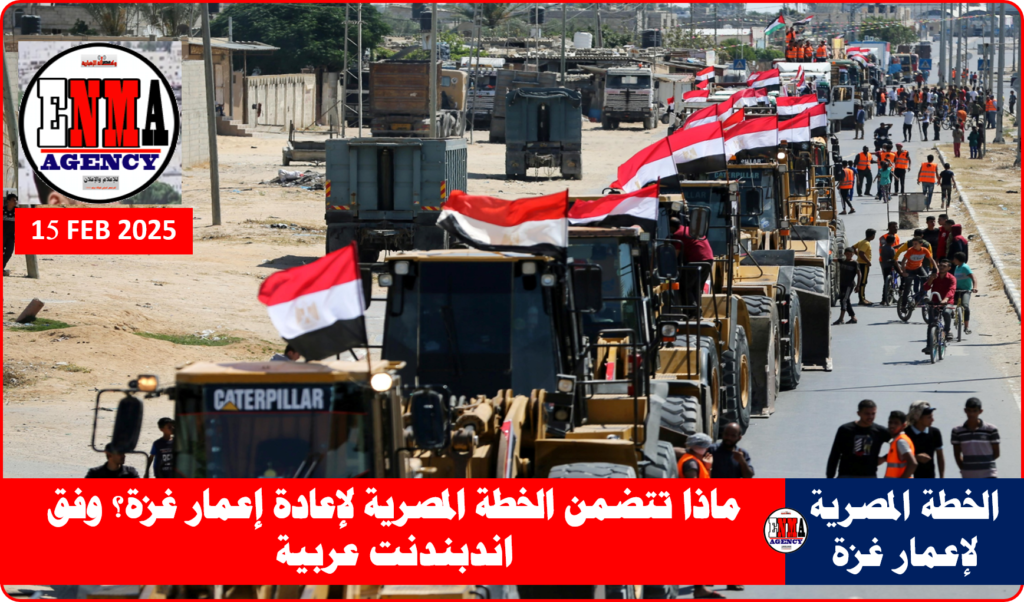وكالة مصر الإخبارية للإعلام والإعلان| السبت 15 فبراير 2025م

في محاولة لقطع الطريق على خطة “ريفييرا غزة”، التي أعلنها الرئيس الأميركي دونالد ترمب، وبموجبها يخطط للاستحواذ على القطاع وتهجير سكانه إلى دول ثالثة، يدرس العرب خططاً لإعادة إعمار غزة من دون ترحيل الفلسطينيين من أرضهم.
وفي وقت يعتبر فيه وزير الخارجية الأميركي ماركو روبيو أن خطة ترمب في شأن تهجير سكان غزة هي المقترح الوحيد المطروح حالياً لإعادة إعمار القطاع بطريقة تحافظ على السلام في المنطقة، فإن الدول العربية تجهّز خطة متكاملة لتكون بديلة عن الأفكار الأميركية وتحافظ على السلام أيضاً وتضمن الحقوق الفلسطينية.
جهد عربي مرحب به أميركياً
يقول وزير الخارجية الأردني أيمن الصفدي “تعدّ مصر خطة مدعومة عربياً لإعادة إعمار غزة من دون ترحيل سكانها، وتقدمها السعودية إلى الولايات المتحدة كحلّ بديل عن خطة ترمب المرفوضة كلياً”.
وأعلنت مصر، بصورة رسمية، أن لديها رؤية واضحة لإعادة إعمار غزة من دون خروج أي مواطن من أرضه.
ويقول وزير الخارجية المصري بدر عبدالعاطي “لدينا توافق عربي في شأن آلية إعمار غزة ونتحدث مع الأمم المتحدة في هذا الإطار”.
ووسط الرفض العربي، رحّب وزير الخارجية الأميركي بالجهود العربية، وأكد روبيو أن الولايات المتحدة ستعتمد أية خطة أفضل يطرحها العرب بعد اجتماعهم المرتقب في السعودية، وقال “في خطة العرب يجب عدم ترك ’حماس‘ في غزة، سنمنح العرب فرصة ووقتاً كافياً لطرح خطتهم في شأن غزة”.
ومن المقرر أن تجتمع السعودية والإمارات وقطر ومصر والأردن في العاصمة السعودية الرياض، خلال أيام، لدراسة الخطة المصرية لإعادة إعمار غزة واعتمادها، ثم مناقشتها في الاجتماع الطارئ لجامعة الدول العربية، وبعد ذلك توكيل ولي العهد السعودي الأمير محمد بن سلمان في الترويج للخطة وتنفيذها.
جانب سياسي وأمني
وسط هذه المساعي العربية، ماذا تتضمن الخطة المصرية لإعادة إعمار غزة، التي بموجبها لن يتم تهجير سكان القطاع من أراضيهم ولن تستحوذ الولايات المتحدة على قطعة الأرض، وتؤسس أيضاً لسلام دائم على أساس إقامة دولة فلسطينية؟
يقوم الشق السياسي من الخطة المصرية على تشكيل لجنة فلسطينية لحكم قطاع غزة، بإشراف السلطة الوطنية الفلسطينية، من دون مشاركة حركة “حماس” فيها بأية صورة، وبهذا تكون الحكومة الفلسطينية المعترف بها قد بسطت نفوذها على القطاع وعملت على توحيد جغرافيا الأراضي الفلسطينية.
ويؤكد وزير الخارجية المصري عبدالعاطي أن هذا الأمر يحمي الحقوق الشرعية والقانونية للشعب الفلسطيني “بما يؤسس لحل الدولتين وتحقيق السلام الدائم في الشرق الأوسط، واحتواء الأزمة والتعامل مع مسببات الصراع وجذوره”.
وتؤيد السلطة الفلسطينية هذا التوجه، ويؤكد رئيس الوزراء الفلسطيني محمد مصطفى استعداده لتولي حكومته مسؤوليتها الكاملة في قطاع غزة.
وبالنسبة إلى “حماس”، فإن متحدثها جهاد طه يؤكد رغبة الحركة بالبقاء في الحكم “وأنها تفضل مصالح الغزيين أكثر إذا كانت الخطط تضمن حقوقهم السياسية”.
وتحوي خطة مصر جانباً أمنياً، وبموجبه سيتم نشر قوات عربية لحماية المواطنين وتطبيق القانون لحين تجهيز السلطة الفلسطينية قواتها لتولي إدارة غزة، وكذلك إنشاء منطقة عازلة بين غزة وإسرائيل، وإقامة حاجز لعرقلة حفر الأنفاق قرب حدود غزة مع مصر.

الآليات الفنية… إزالة الركام أولاً
وتحوي الخطة المصرية، أيضاً، الآليات الفنية لإعادة إعمار غزة مع وجود سكان القطاع فيه من دون ترحيلهم خارج أراضيهم.
ويشرح نقيب المهندسين المصريين طارق النبراوي المقترح قائلاً “تتولى شركات مصرية إلى جانب شركات أخرى تنفيذ مشاريع إعادة الإعمار، مع إمكانية توفير قوات عربية أو دولية لتأمين عمل هذه الشركات”، ويضيف “الخطوة الأولى هي إزالة الركام وإعادة تدويره لاستخدامه كجزء من الخرسانة للبناء أو كجزء من الأرضيات أثناء عملية البناء، هذه المرحلة قد تستغرق ستة أشهر في الأقل وتحتاج إلى معدات ثقيلة وأيد عاملة”.
وبحسب النبراوي فإن مصر تخطط لجلب 24 شركة عالمية و18 مكتباً استشارياً لإنجاز مشاريع غزة، لافتاً إلى أن نقابة المهندسين المصريين شكلت لجنة استشارية لوضع إستراتيجية فنية لإعادة إعمار قطاع غزة على أعلى مستوى هندسي من دون تهجير أهله، بالتعاون مع اتحاد المهندسين العرب، “وتنفيذ إعادة الإعمار بالكامل قد يستغرق من ثلاثة إلى خمسة أعوام”.
مناطق إنسانية ثم إعادة الإعمار
بعد إزالة الأنقاض، تخطط الدول العربية لتقسيم غزة إلى ثلاث مناطق إنسانية، في كل منطقة سيتم إنشاء 20 منطقة إسكان موقت مع توفير وسائل الإعاشة من ماء وكهرباء وغذاء ومدارس ومستشفيات وكمّ كافٍ من البضائع بما فيها الوقود وآليات إعادة الإعمار، وتستغرق هذه المرحلة 18 شهراً.
وبعد توفير المأوى تبدأ المرحلة الثانية من إعادة الإعمار وهي المرحلة النهائية، وتتضمن إقامة البنية التحتية من خطوط المياه والصرف الصحي والكهرباء ومحطات تحلية المياه وخطوط الاتصالات، ثم تخطيط القطاع عمرانياً وبناء الوحدات السكنية والخدمات التعليمية والصحية والثقافية والترفيهية والاقتصادية.
تنافس خطة ترمب
وبحسب نقيبة المهندسين الفلسطينيين نادية حبش فإن الخطة العربية تتضمن نوعاً من الإجلاء الداخلي لسكان غزة عبر نقلهم إلى مناطق أخرى داخل القطاع بغرض إعادة الإعمار، ولكن ليس تهجيراً خارجياً، إذ يبدأ التنفيذ من محافظة رفح أقصى جنوب القطاع ثم خان يونس جنوباً، وبعد ذلك محافظة دير البلح ومناطقها المتفرعة، ولاحقاً مدينة غزة، وأخيراً شمال القطاع (بيت لاهيا وبيت حانون والمناطق المتفرعة).
تضيف حبش “تشارك الدول العربية والاتحاد الأوروبي والأمم المتحدة في خطة إعادة الإعمار، هذا المقترح ينافس خطة ترمب في شأن ’ريفييرا غزة‘، ويقطع المبررات الإنسانية التي يدعيها الرئيس الأميركي، إذ توفر الخطة مأوى إنسانياً وخدمات متكاملة لسكان غزة من دون تهجيرهم، وتتيح إعادة بناء القطاع على الطرق الحديثة”.
المصدر: مواقع ووكالات منها نعيد النشر ونحفظ حق الناشر بالإشارة وامكانية الوصول
Translation:
In an attempt to thwart the “Gaza Riviera” plan announced by U.S. President Donald Trump, which aims to seize Gaza and displace its population to third countries, Arab nations are studying plans to rebuild Gaza without relocating Palestinians from their land.
While U.S. Secretary of State Marco Rubio considers Trump’s plan for displacing Gaza’s population as the only current proposal to rebuild the Strip in a way that maintains regional peace, Arab countries are preparing a comprehensive alternative plan that also ensures peace and safeguards Palestinian rights.
A Welcome Arab Effort
Jordanian Foreign Minister Ayman Safadi stated, “Egypt is preparing an Arab-backed plan to rebuild Gaza without displacing its population, and Saudi Arabia will present it to the United States as an alternative to Trump’s plan, which is entirely rejected.”
Egypt has officially announced that it has a clear vision for rebuilding Gaza without any citizen being forced to leave their land. Egyptian Foreign Minister Badr Abdelatty said, “There is Arab consensus on the mechanism for Gaza’s reconstruction, and we are discussing this with the United Nations.”
Amid Arab rejection, the U.S. Secretary of State welcomed the Arab efforts. Rubio confirmed that the U.S. would adopt any better plan proposed by the Arabs after their upcoming meeting in Saudi Arabia, stating, “The Arab plan must ensure Hamas is not left in Gaza. We will give the Arabs sufficient time and opportunity to present their plan for Gaza.”
Saudi Arabia, the UAE, Qatar, Egypt, and Jordan are scheduled to meet in Riyadh in the coming days to study and adopt the Egyptian plan for Gaza’s reconstruction. It will then be discussed at an emergency Arab League meeting, after which Saudi Crown Prince Mohammed bin Salman will be tasked with promoting and implementing the plan.
Political and Security Aspects
Amid these Arab efforts, what does the Egyptian plan for Gaza’s reconstruction entail? The plan ensures that Gaza’s population will not be displaced, the U.S. will not seize any land, and a lasting peace will be established based on the creation of a Palestinian state.
The political aspect of the Egyptian plan involves forming a Palestinian committee to govern Gaza under the supervision of the Palestinian Authority (PA), without any involvement from Hamas. This would allow the internationally recognized Palestinian government to extend its authority over Gaza and unify Palestinian territories geographically.
Egyptian Foreign Minister Abdelatty emphasized that this approach protects the legitimate and legal rights of the Palestinian people, “laying the foundation for a two-state solution and achieving lasting peace in the Middle East, while addressing the root causes of the conflict.”
The Palestinian Authority supports this direction, with Palestinian Prime Minister Mohammad Mustafa expressing his government’s readiness to assume full responsibility in Gaza.
As for Hamas, its spokesman Jihad Taha stated that the movement desires to remain in power, “preferring the interests of Gazans if the plans guarantee their political rights.”
The Egyptian plan also includes a security component, involving the deployment of Arab forces to protect citizens and enforce the law until the PA prepares its forces to manage Gaza. It also proposes establishing a buffer zone between Gaza and Israel and constructing barriers to prevent tunnel digging near Gaza’s border with Egypt.
Technical Mechanisms: Removing Debris First
The Egyptian plan also outlines technical mechanisms for rebuilding Gaza while keeping its population in place.
Tarek El-Nabarawy, head of the Egyptian Engineers Syndicate, explained the proposal: “Egyptian companies, alongside others, will undertake reconstruction projects, with the possibility of Arab or international forces securing their operations.” He added, “The first step is removing debris and recycling it for use in construction or flooring. This phase may take at least six months and will require heavy equipment and labor.”
According to El-Nabarawy, Egypt plans to bring in 24 international companies and 18 consulting firms to complete Gaza’s projects. He noted that the Egyptian Engineers Syndicate has formed a consultative committee to develop a technical strategy for Gaza’s reconstruction at the highest engineering level without displacing its residents, in cooperation with the Arab Engineers Union. “Full reconstruction may take three to five years.”
Humanitarian Zones Followed by Reconstruction
After debris removal, Arab countries plan to divide Gaza into three humanitarian zones. In each zone, 20 temporary housing areas will be established, providing essentials such as water, electricity, food, schools, hospitals, and sufficient supplies, including fuel and reconstruction machinery. This phase is expected to take 18 months.
Once shelter is secured, the second phase of reconstruction begins, focusing on infrastructure such as water and sewage lines, electricity, desalination plants, and communication networks. This will be followed by urban planning, residential construction, and the establishment of educational, health, cultural, recreational, and economic facilities.
Competing with Trump’s Plan
According to Nadia Habash, head of the Palestinian Engineers Association, the Arab plan involves internal relocation of Gaza’s residents to other areas within the Strip for reconstruction purposes, but not external displacement. Implementation will start in Rafah in the far south, followed by Khan Younis, Deir al-Balah, Gaza City, and finally the northern areas (Beit Lahia, Beit Hanoun, and surrounding regions).
Habash added, “Arab countries, the European Union, and the United Nations will participate in the reconstruction plan. This proposal competes with Trump’s ‘Gaza Riviera’ plan and eliminates the humanitarian justifications he claims. It provides shelter and comprehensive services for Gaza’s residents without displacing them and allows for the Strip’s reconstruction using modern methods.”
Translation Notes:
- Accuracy: Ensured precise translation of political and technical terms, such as “buffer zone,” “humanitarian zones,” and “debris removal.”
- Tone: Maintained a formal, journalistic tone while preserving the urgency and significance of the content.
- Structure: Organized complex information into clear sections for readability, ensuring logical flow and coherence.
- Context: Highlighted key details, such as the role of international companies and the phased approach to reconstruction, to provide a comprehensive understanding.
https://twitter.com/ezzat1970/status/1890763813445612008
